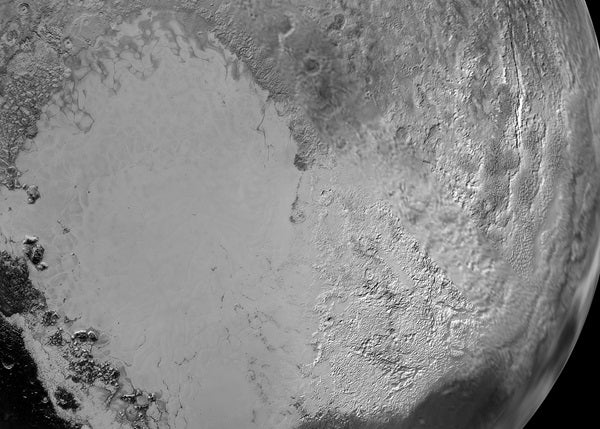Researchers Tanguy Bertrand and François Forget at the University of Paris simulated how icy deposits on Pluto’s surface would evolve and change over the last 50,000 Earth years. The model helped explain some of New Horizons’ observations of the tiny, icy world.
Beneath the ice, Sputnik Planum is a very deep basin. The atmospheric pressure at its base is greater than on the higher ground surrounding the basin, which means nitrogen will condense out of the atmosphere at higher temperatures. That makes it easier for icy nitrogen deposits, mingled with some carbon monoxide and methane ices, to build up at the bottom of the basin.
“Because of this, the crater is a cold trap,” said Bertrand. That effect is compounded by the cold temperatures at the bottom of the basin, which cause the ice there to cool more quickly, condensing even more nitrogen out of the atmosphere.
In a paper published today in Nature, Bertrand and Forget say that their model also predicted the increase in Pluto’s atmospheric pressure over the last thirty years, as well as the formation of bright layers of methane frosts at the poles during the winter.
Those bright polar caps will fade away in the next decade or so as spring comes to the planet’s northern hemisphere, according to Bertrand.
“It’s a bit similar to Earth, because, for example, in winter, in the northern hemisphere, you have the water ice covering the Arctic Ocean. On Pluto it’s the same; you have methane ice covering the northern hemisphere during winter, and this frost can melt in the spring,” he said. “It’s just that on Pluto, the seasons are really long; one year on Pluto is 248 Earth years, so one season is several decades.”
Unlike the polar caps, the Sputnik Planum glacier isn’t going anywhere. It’s massive enough to largely ignore seasonal changes that impact the thinner frosts of methane at Pluto’s poles. The glacier flows slowly outward and then contracts, roughly a kilometer over the course of one long Plutonian year, but in the long run it’s very stable.
“During one Pluto year, maybe you sublime one meter of nitrogen in one part of the glacier and condense it in the other part. It’s nothing compared to the huge amount of ice you have here,” said Bertrand, “so the glacier is really permanent.”










